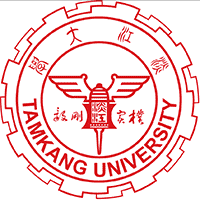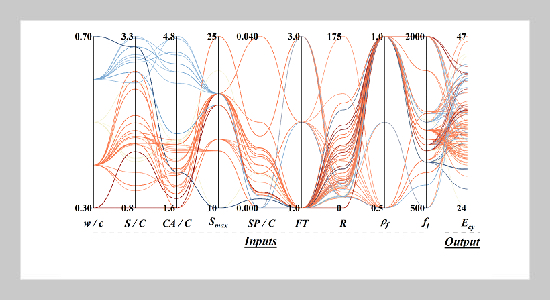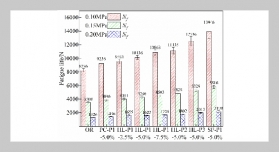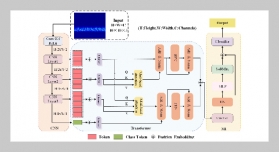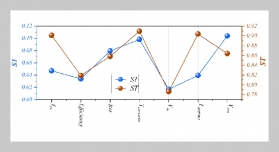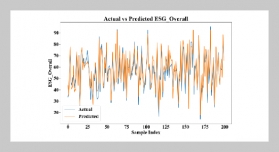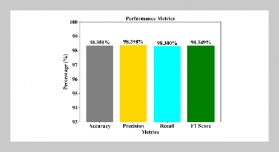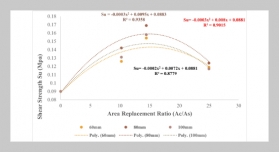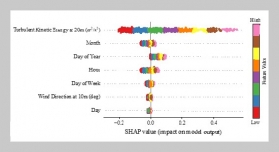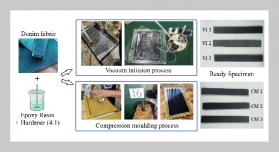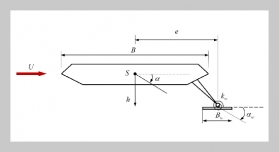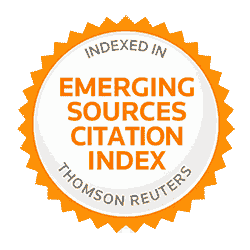- [1] B. Bennett, P. Visintin, and T. Xie, (2022) “Global warming potential of recycled aggregate concrete with supplementary cementitious materials" Journal of Building Engineering 52: 104394. DOI: https://doi.org/10. 1016/j.jobe.2022.104394.
- [2] R. S. Benemaran, M. Esmaeili-Falak, and M. S. Kord lar, (2024) “Improvement of recycled aggregate concrete using glass fiber and silica fume" Multiscale and Multidisciplinary Modeling, Experiments and Design 7: 1895–1914. DOI: https://doi.org/10.1007/s41939 023-00313-2.
- [3] B. D. G. Sepulveda, P. Visintin, and D. J. Oehlers, (2022) “Fatigue bond-slip properties of steel reinforcing bars embedded in UHPFRC: Extraction and development of an accumulated damage law" Case Studies in Construction Materials 17: e01370. DOI: https: //doi.org/10.1016/j.cscm.2022.e01370.
- [4] Y. Yu, X.-Y. Zhao, J.-J. Xu, S.-C. Wang, and T.-Y. Xie, (2022) “Evaluation of shear capacity of steel fiber rein forced concrete beams without stirrups using artificial intelligence models" Materials 15: 2407. DOI: https: //doi.org/10.3390/ma15072407.
- [5] Y. Yu, X.-Y. Zhao, J.-J. Xu, S.-C. Wang, and T.-Y. Xie, (2022) “Evaluation of shear capacity of steel fiber rein forced concrete beams without stirrups using artificial intelligence models" Materials 15: 2407. DOI: https: //doi.org/10.3390/ma15072407.
- [6] X.-Q. Qu, R. Wang, J.-M. Zhang, and B. He, (2023) “Influence of soil plug on the seismic response of bucket foundations in liquefiable seabed" Journal of Marine Science and Engineering 11: 598. DOI: https: //doi.org/10.3390/jmse11030598.
- [7] X. Wu, F. Ding, P. Xiang, Y. Wang, Z. Yu, and C. Liu, (2022) “Multiaxial damage ratio strength criteria for fiber reinforced concrete" Journal of Engineering Mechanics 148: 04022029. DOI: https: //doi.org/10.1061/(ASCE)EM.1943-7889.0002109.
- [8] M. Esmaeili-Falak and R. S. Benemaran, (2024) “Ap plication of optimization-based regression analysis for evaluation of frost durability of recycled aggregate concrete" Structural Concrete 25: 716–737. DOI: https: //doi.org/10.1002/suco.202300566.
- [9] S. Kim, M. Usman, C. Park, and A. Hanif, (2021) “Durability of slag waste incorporated steel fiber-reinforced concrete in marine environment" Journal of Building Engineering 33: 101641. DOI: https: //doi.org/10.1016/j.jobe.2020.101641.
- [10] C. Frazão, A. Camões, J. Barros, and D. Gonçalves, (2015) “Durability of steel fiber reinforced self-compacting concrete" Construction and Building Materials 80: 155–166. DOI: https: //doi.org/10.1016/j.conbuildmat.2015.01.061.
- [11] A. Parvez and S. J. Foster, (2015) “Fatigue behavior of steel-fiber-reinforced concrete beams" Journal of Structural Engineering 141: 04014117. DOI: https://doi.org/10.1061/(ASCE)ST.1943-541X.0001074.
- [12] L. Jin, R. Zhang, G. Dou, and X. Du, (2018) “Fire resistance of steel fiber reinforced concrete beams after low velocity impact loading" Fire Safety Journal 98: 24–37. DOI: https: //doi.org/10.1016/j.firesaf.2018.04.003.
- [13] X. H. Wang, S. Jacobsen, J. Y. He, Z. L. Zhang, S. F. Lee, and H. L. Lein, (2009) “Application of nanoindentation testing to study of the interfacial transition zone in steel fiber reinforced mortar" Cement and Concrete Research 39: 701–715. DOI: https: //doi.org/10.1016/j.cemconres.2009.05.002.
- [14] R. Mu, Y. F. Ma, H. Li, X. W. Wang, and P. Zhang, (2015) “Analysis of the distribution of steel fiber in aligned steel fiber reinforced concrete using digital X-ray CT scanning" Journal of Chinese Electron Microscopy Society: 487–491.
- [15] W. Abbass, M. I. Khan, and S. Mourad, (2018) “Evaluation of mechanical properties of steel fiber reinforced concrete with different strengths of concrete" Construction and building materials 168: 556–569. DOI: https: //doi.org/10.1016/j.conbuildmat.2018.02.164.
- [16] Y. H. Luo, J. L. Liang, D. S. Yang, B. W. Zhou, B. Hu, and L. Yang, (2018) “Configuration and operation optimization of electricity-gas-heat energy hub considering reliability" Automation of Electric Power Systems 42: 47–54.
- [17] M.H.JamshidiandM.Arefi,(2024)“Elasticanalysisof functionally graded porous cylinders under uniform internal pressure by using shear deformation theory" Mechanics of Advanced Materials and Structures 31: 11393 11412. DOI: https: //doi.org/10.1080/15376494.2024.2304154.
- [18] L.Wu,Z.Xiang,H.Jiang,M.Liu,X.Ju,andW.Zhang, (2022) “A review of durability issues of reinforced concrete structures due to coastal soda residue soil in China" Journal of Marine Science and Engineering 10: 1740. DOI: https: //doi.org/10.3390/jmse10111740.
- [19] T.Y.Zhu,(2011) “The mechanical properties of steel fiber reinforced concrete at low fiber content" Zhengzhou: Zhengzhou University:
- [20] M. Açikgenç, M. Ula¸s, and K. E. Alyamaç, (2015) “Using an artificial neural network to predict mix compositions of steel fiber-reinforced concrete" Arabian Journal for Science and Engineering 40: 407–419. DOI: https: //doi.org/10.1007/s13369-014-1549-x.
- [21] M. Esmaeili-Falak and R. S. Benemaran, (2024) “Ensemble extreme gradient boosting based models to predict the bearing capacity of micropile group" Applied Ocean Research 151: 104149. DOI: https: //doi.org/10.1016/j.apor.2024.104149.
- [22] Y. Zhu, L. Huang, Z. Zhang, and B. Bayrami, (2022) “Estimation of splitting tensile strength of modified recycled aggregate concrete using hybrid algorithms" Steel and Composite Structures: 389–406. DOI: https: //doi.org/10.12989/scs.2022.44.3.389.
- [23] B. M. Yaychi and M. Esmaeili-Falak, (2024) “Estimating axial bearing capacity of driven piles using tuned random forest frameworks" Geotechnical and Geological Engineering 42: 7813–7834. DOI: https: //doi.org/10.1007/s10706-024-02952-9.
- [24] Y. Dawei, Z. Bing, G. Bingbing, G. Xibo, and B. Razza ghzadeh, (2023) “Predicting the CPT-based pile set-up parameters using HHO-RF and PSO-RF hybrid mod els" Structural Engineering and Mechanics, An Int’l Journal 86: 673–686. DOI: http: //dx.doi.org/10.12989/sem.2023.86.5.673.
- [25] R. Liang and B. Bayrami, (2022) “Estimation of frost durability of recycled aggregate concrete by hybridized Random Forests algorithms" Steel and Composite Structures: 91–107. DOI: https: //doi.org/10.12989/scs.2023.49.1.091.
- [26] M. Esmaeili-Falak, H. Katebi, M. Vadiati, and J. Adamowski, (2019) “Predicting triaxial compressive strength and Young’s modulus of frozen sand using artificial intelligence methods" Journal of Cold Regions Engineering 33: 04019007. DOI: https: //doi.org/10.1061/(ASCE)CR.1943-5495.0000188.
- [27] K. Zhang, Y. Zhang, and B. Razzaghzadeh, (2024) “Application of the optimal fuzzy-based system on bearing capacity of concrete pile" Steel and Composite Structures 51: 25–41. DOI: https: //doi.org/10.12989/scs.2024.51.1.025.
- [28] M. Açikgenç, M. Ula¸s, and K. E. Alyamaç, (2015) “Using an artificial neural network to predict mix compositions of steel fiber-reinforced concrete" Arabian Journal for Science and Engineering 40: 407–419. DOI: https: //doi.org/10.1007/s13369-014-1549-x.
- [29] T. F. Awolusi, O. L. Oke, O. O. Akinkurolere, A. O. Sojobi, and O. G. Aluko, (2019) “Performance comparison of neural network training algorithms in the modeling properties of steel fiber reinforced concrete" Heliyon 5: DOI: https: //doi.org/10.1016/j.heliyon.2018.e01115.
- [30] O. Karahan, H. Tanyildizi, and C. D. Atis, (2008) “An artificial neural network approach for prediction of long term strength properties of steel fiber reinforced concrete containing fly ash" Journal of Zhejiang University SCIENCEA9:1514–1523. DOI: https: //doi.org/10.1631/jzus.A0720136.
- [31] Y. ¸Sahin and F. Köksal, (2011) “The influences of matrix and steel fibretensile strengths on the fracture energy of high-strength concrete" Construction and Building Materials 25: 1801–1806. DOI: https: //doi.org/10.1016/j.conbuildmat.2010.11.084.
- [32] J. G. Yue, Y. F. Xia, and H. Fang, (2021) “Experimental study on fracture mechanism and tension damage constitutive relationship of steel fiber reinforced concrete" China Civ. Eng. J 54: 93–106.
- [33] I. S. Ibrahim and M. B. C. Bakar, (2011) “Effects on mechanical properties of industrialised steel fibres addition to normal weight concrete" Procedia engineering 14: 2616–2626. DOI: https://doi.org/10.1016/j.proeng.2011.07.329.
- [34] N. Buratti, C. Mazzotti, and M. Savoia, (2011) “Post cracking behaviour of steel and macro-synthetic fibre reinforced concretes" Construction and building materials 25: 2713–2722. DOI: https: //doi.org/10.1016/j.conbuildmat.2010.12.022.
- [35] B. R. Rajeshwari and M. V. N. Sivakumar, (2020) “In fluence of coarse aggregate properties on specific fracture energy of steel fiber reinforced self compacting concrete" Advances in concrete construction: 173–181. DOI: https: //doi.org/10.12989/acc.2020.9.2.173.
- [36] Q. Li, Y. Fang, Y. Chen, Q. Wu, G. Lin, and Z. Pang, (2020) “Experimental study on mechanical properties of concrete with adding steel fiber at early age" Concrete 6: 102–105.
- [37] L. L. Niu, S. P. Zhang, and Y. X. Wei, (2019) “Effect of fiber dosage on the mechanical property of SFRC" China Concr. Cem. Prod 3:
- [38] M. Gul, A. Bashir, and J. A. Naqash, (2014) “Study of modulus of elasticity of steel fiber reinforced concrete" Int. J. Eng. Adv. Technol 3: 304–309.
- [39] F. Minelli, A. Conforti, E. Cuenca, and G. Plizzari, (2014) “Are steel fibres able to mitigate or eliminate size effect in shear?" Materials and structures 47: 459–473. DOI: https: //doi.org/10.1617/s11527-013-0072-y.
- [40] G. Tiberti, F. Minelli, and G. Plizzari, (2015) “Cracking behavior in reinforced concrete members with steel fibers: A comprehensive experimental study" Cement and concrete research 68: 24–34. DOI: https: //doi.org/10.1016/j.cemconres.2014.10.011.
- [41] T.Y.Zhu,(2011) “The mechanical properties of steel fiber reinforced concrete at low fiber content" Zhengzhou: Zhengzhou University:
- [42] W.Zhao,L. Wang, Z. Zhang, H. Fan, J. Zhang, S. Mir jalili, N. Khodadadi, and Q. Cao, (2024) “Electric eel foraging optimization: A new bio-inspired optimizer for engineering applications" Expert systems with applications 238: 122200. DOI: https: //doi.org/10.1016/j.eswa.2023.122200.
- [43] S. Zhao, T. Zhang, S. Ma, and M. Wang, (2023) “Sea horse optimizer: a novel nature-inspired meta-heuristic for global optimization problems" Applied Intelligence 53: 11833–11860. DOI: https: //doi.org/10.1007/s10489-022-03994-3.
- [44] G. K. F. Tso and K. K. W. Yau, (2007) “Predicting electricity energy consumption: A comparison of regression analysis, decision tree and neural networks" Energy 32: 1761–1768. DOI: https: //doi.org/10.1016/j.energy.2006.11.010.
- [45] S. Araki, M. Shima, and K. Yamamoto, (2018) “Spatiotemporal land use random forest model for estimating metropolitan NO2 exposure in Japan" Science of The Total Environment 634: 1269–1277. DOI: https: //doi.org/10.1016/j.scitotenv.2018.03.324.
- [46] H. Hong, H. R. Pourghasemi, and Z. S. Pourtaghi, (2016) “Landslide susceptibility assessment in Lianhua County (China): a comparison between a random forest data mining technique and bivariate and multivariate statistical models" Geomorphology 259: 105–118. DOI: https: //doi.org/10.1016/j.geomorph.2016.02.012.
- [47] O. Rahmati, H. R. Pourghasemi, and A. M. Melesse, (2016) “Application of GIS-based data driven random forest and maximum entropy models for groundwater potential mapping: a case study at Mehran Region, Iran" Catena 137: 360–372. DOI: https: //doi.org/10.1016/j.catena.2015.10.010.
- [48] J. H. Jeong, J. P. Resop, N. D. Mueller, D. H. Fleisher, K. Yun, E. E. Butler, D. J. Timlin, K.-M. Shim, J. S. Gerber, and V. R. Reddy, (2016) “Random forests for global and regional crop yield predictions" PloS one 11: e0156571. DOI: https: //doi.org/10.1371/journal.pone.0156571.
- [49] H. Rao, X. Shi, A. K. Rodrigue, J. Feng, Y. Xia, M. Elhoseny, X. Yuan, and L. Gu, (2019) “Feature selection based on artificial bee colony and gradient boosting decision tree" Applied Soft Computing 74: 634–642. DOI: https: //doi.org/10.1016/j.asoc.2018.10.036.
